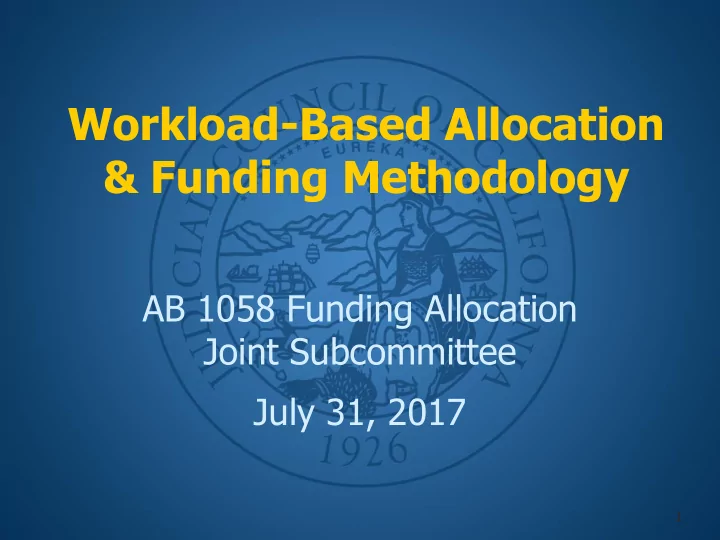

Workload-Based Allocation & Funding Methodology AB 1058 Funding Allocation Joint Subcommittee July 31, 2017 1
WAFM • Workload model based upon the Resource Assessment Study (RAS) • Calculates an estimate of funding needed, by court, for non-judicial, filings-driven functions • Compares the estimated funding need to available funding • Establishes methodology for allocation if available funding is less than funding needed 2
WAFM • RAS calculated the number of employees needed. • Total cost of employees is then calculated • Salary is calculated using an average cost adjusted for cost of labor differences • Actual retirement and health costs are included 3
WAFM • An estimation of non-personnel costs needed for operations • Higher amounts are provided for small court expenses due to lack of economy of scale • A base funding floor to reflect the minimum level of funding needed to operate regardless of filings 4
Bureau of Labor Statistics Factor • Identifies labor cost differences between courts. (e.g., San Francisco labor is more expensive than Sacramento labor) • Local government is used as the comparison for most, except in counties with high proportions of state employment • Three-year average used to smooth any fluctuations 5
WAFM Small Court Adjustments: • FTE Allotment Factor • OE&E per FTE • Absolute and graduated funding floors 6
WAFM What it doesn’t include: • Costs associated with programs that have dedicated funding sources • Such programs include AB 1058 grant program, enhanced collections, dependency counsel, security, subordinate judicial officers, and interpreters 7
WAFM What it doesn’t require: • How courts structure positions • The number and make up of court staff • The actual salaries courts pay specific classifications 8
How was WAFM Implemented? • 2013-2014 allocations were used to establish historical base • Judicial Council approved a five-year transition plan through 2017-2018: • 2013-2014 – 90% historical vs. 10% WAFM • 2014-2015 – 85% historical vs. 15% WAFM • 2015-2016 – 70% historical vs. 30% WAFM • 2016-2017 – 60% historical vs. 40% WAFM • 2017-2018 – 50% historical vs. 50% WAFM 9
How was WAFM Implemented? • Any new money appropriated for general trial court operations is allocated using WAFM • For each new dollar received, a dollar of historical base funding is then reallocated using WAFM 10
Funding Methodology Subcommittee • This subcommittee, formed in July 2013, focuses on the ongoing review and refinement of WAFM • The subcommittee established a work plan which is updated annually 11
End of Presentation 12
Recommend
More recommend